Dominos Case Study: Organizational Behavior and Management
VerifiedAdded on 2021/10/01
|11
|2969
|202
Case Study
AI Summary
This case study examines Domino's, focusing on organizational behavior, leadership, and team dynamics. The analysis covers recruitment methods, the impact of culture and leadership styles, and the role of team conflicts. The study explores effective team formation, selection criteria, and the importance of diversity and inclusion in the workplace. It also delves into conflict and stress management, highlighting the consequences of group conflicts and their impact on employees, teams, and the organization. The study suggests leadership approaches like transformational and democratic styles, along with the Kaizen method for continuous improvement. Recommendations for managing diversity and fostering a positive work environment are provided, along with suggestions for handling conflicts and promoting employee well-being. The study concludes by emphasizing the importance of effective leadership and organizational strategies for success.
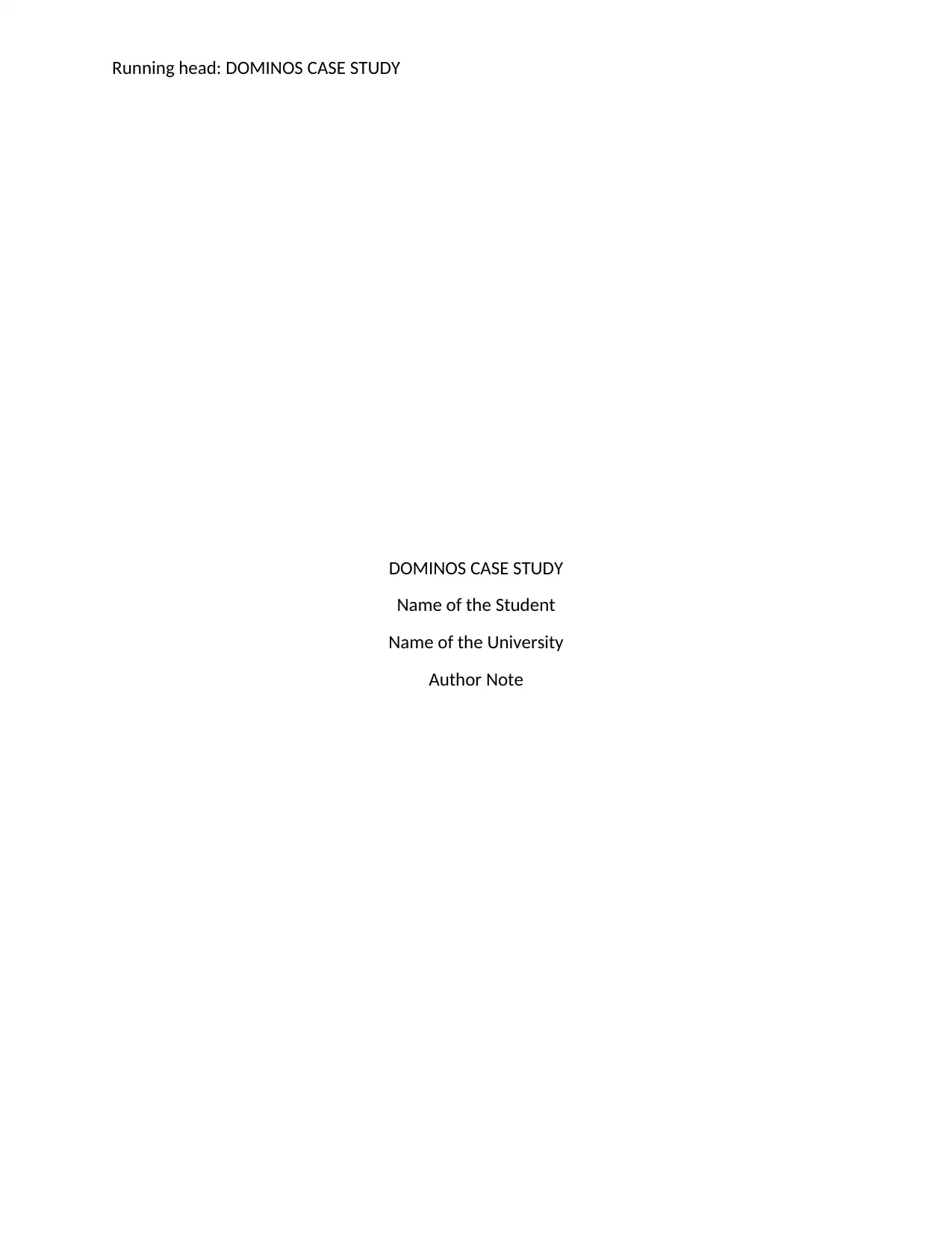
Running head: DOMINOS CASE STUDY
DOMINOS CASE STUDY
Name of the Student
Name of the University
Author Note
DOMINOS CASE STUDY
Name of the Student
Name of the University
Author Note
Paraphrase This Document
Need a fresh take? Get an instant paraphrase of this document with our AI Paraphraser
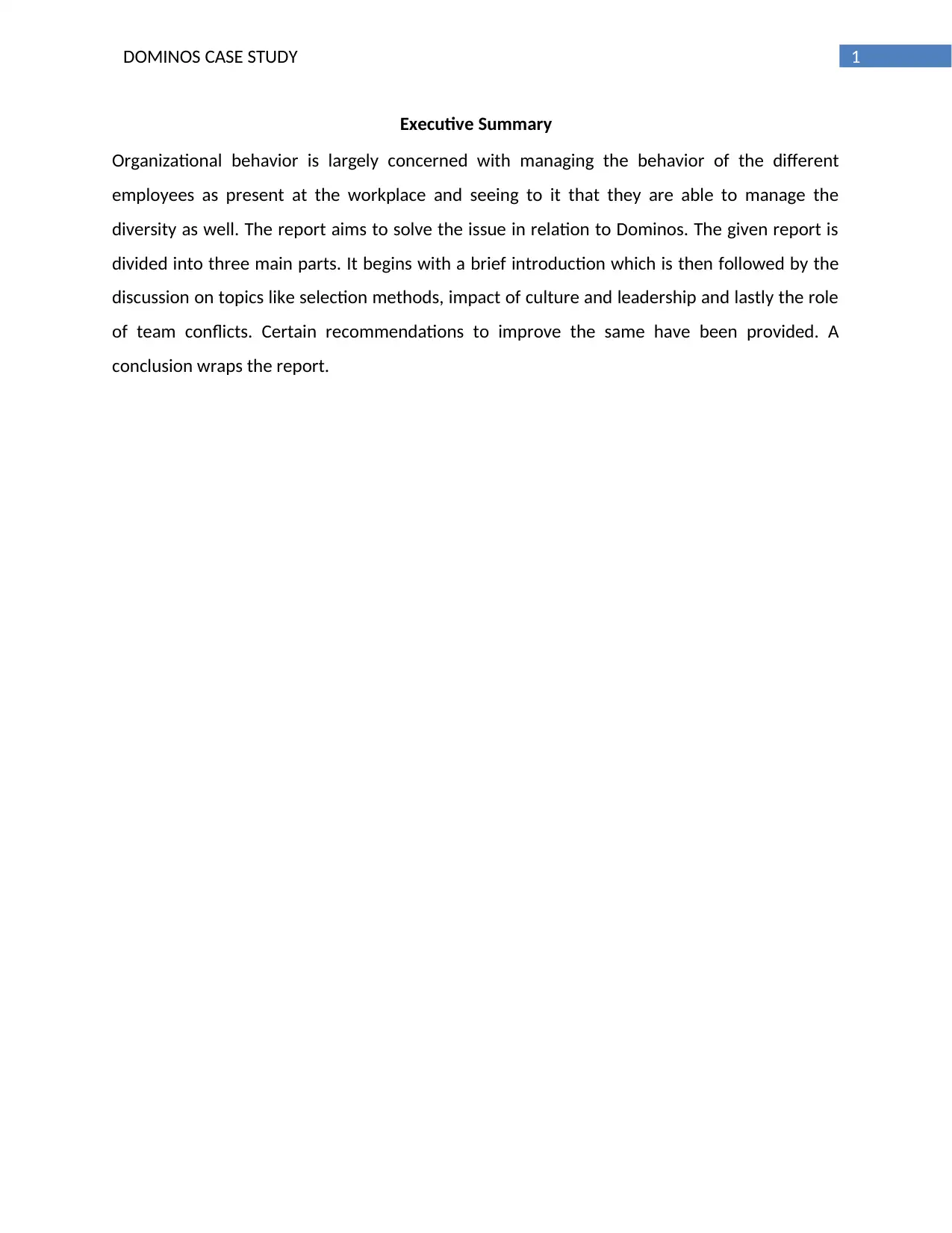
1DOMINOS CASE STUDY
Executive Summary
Organizational behavior is largely concerned with managing the behavior of the different
employees as present at the workplace and seeing to it that they are able to manage the
diversity as well. The report aims to solve the issue in relation to Dominos. The given report is
divided into three main parts. It begins with a brief introduction which is then followed by the
discussion on topics like selection methods, impact of culture and leadership and lastly the role
of team conflicts. Certain recommendations to improve the same have been provided. A
conclusion wraps the report.
Executive Summary
Organizational behavior is largely concerned with managing the behavior of the different
employees as present at the workplace and seeing to it that they are able to manage the
diversity as well. The report aims to solve the issue in relation to Dominos. The given report is
divided into three main parts. It begins with a brief introduction which is then followed by the
discussion on topics like selection methods, impact of culture and leadership and lastly the role
of team conflicts. Certain recommendations to improve the same have been provided. A
conclusion wraps the report.
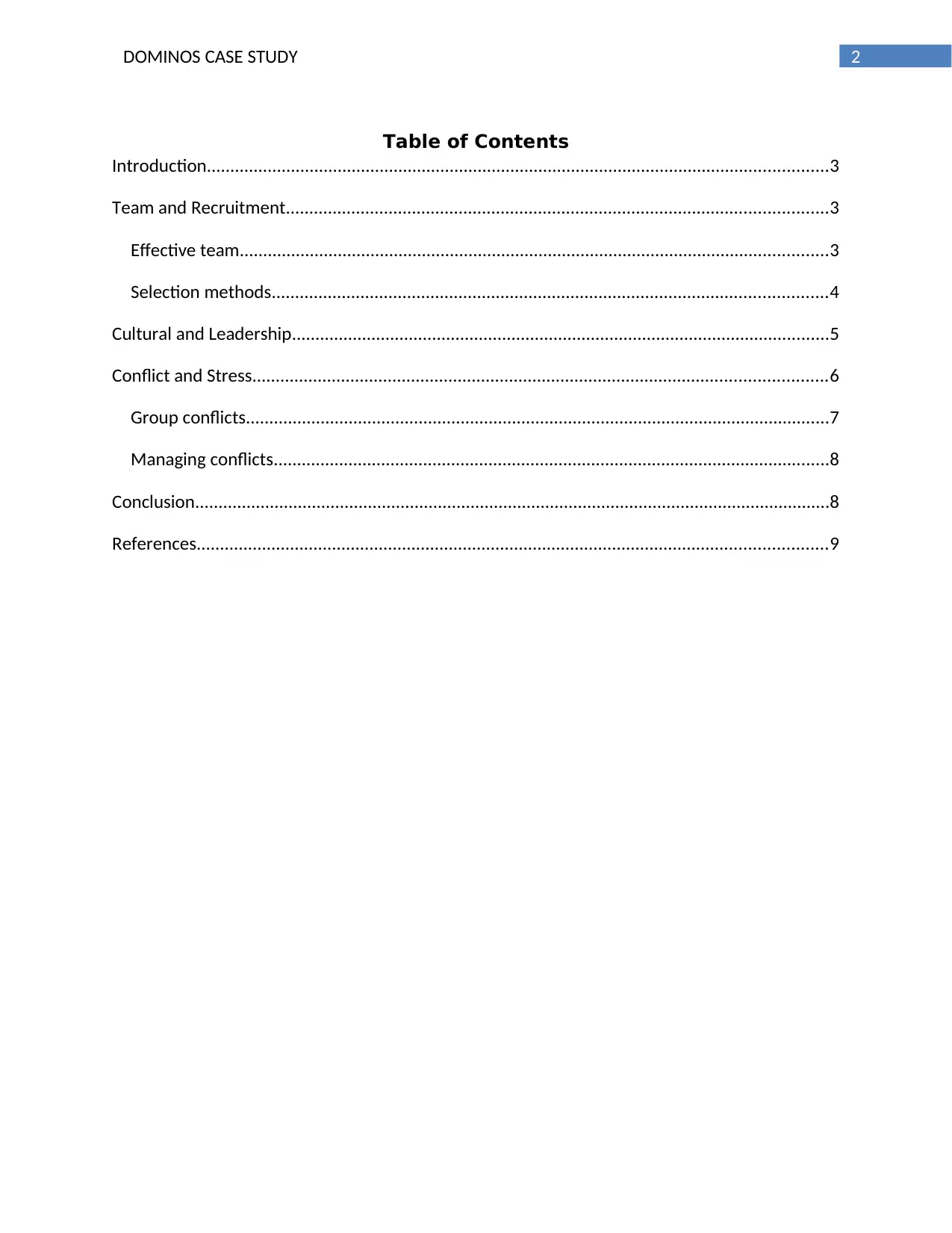
2DOMINOS CASE STUDY
Table of Contents
Introduction.....................................................................................................................................3
Team and Recruitment....................................................................................................................3
Effective team..............................................................................................................................3
Selection methods.......................................................................................................................4
Cultural and Leadership...................................................................................................................5
Conflict and Stress...........................................................................................................................6
Group conflicts.............................................................................................................................7
Managing conflicts.......................................................................................................................8
Conclusion........................................................................................................................................8
References.......................................................................................................................................9
Table of Contents
Introduction.....................................................................................................................................3
Team and Recruitment....................................................................................................................3
Effective team..............................................................................................................................3
Selection methods.......................................................................................................................4
Cultural and Leadership...................................................................................................................5
Conflict and Stress...........................................................................................................................6
Group conflicts.............................................................................................................................7
Managing conflicts.......................................................................................................................8
Conclusion........................................................................................................................................8
References.......................................................................................................................................9
⊘ This is a preview!⊘
Do you want full access?
Subscribe today to unlock all pages.

Trusted by 1+ million students worldwide
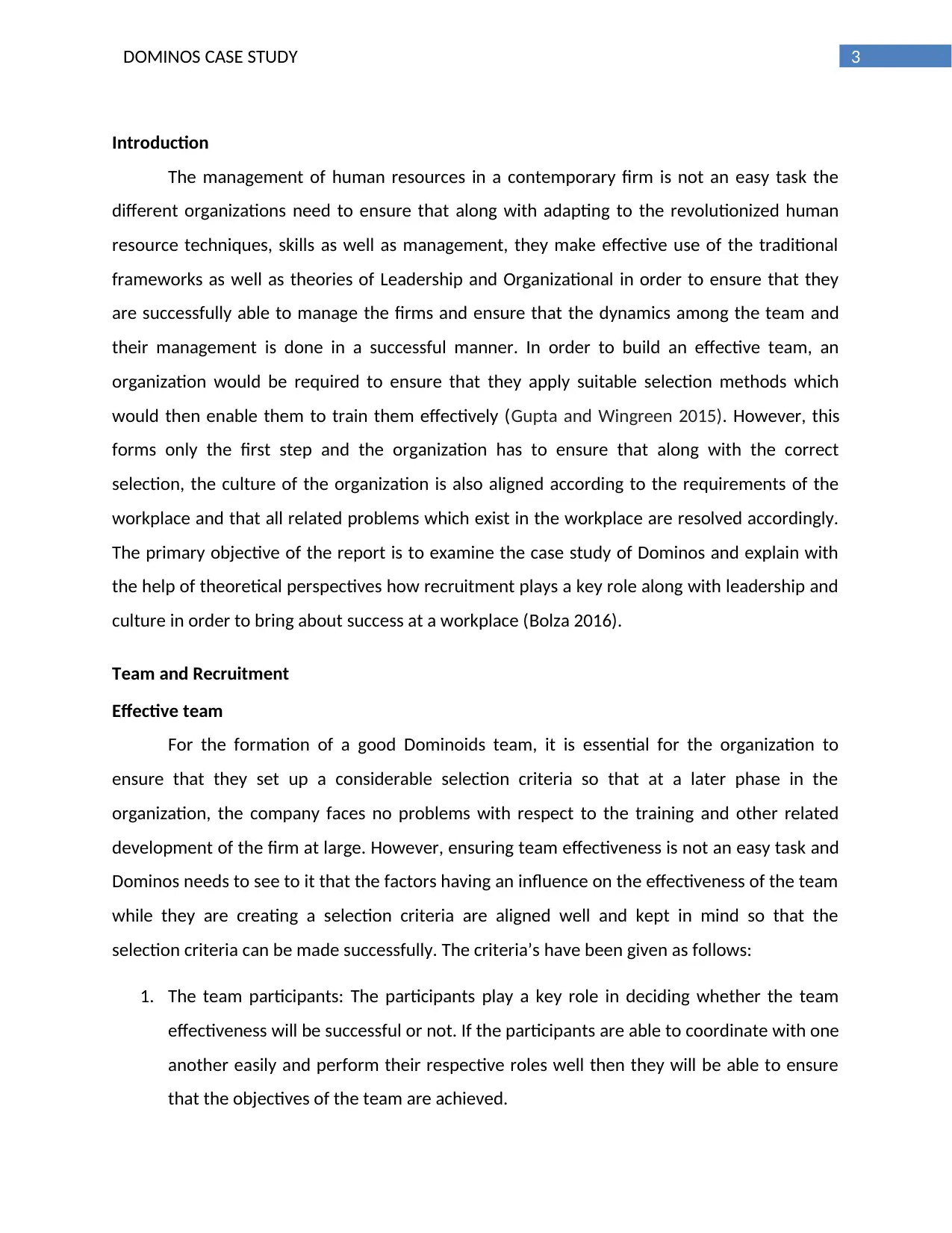
3DOMINOS CASE STUDY
Introduction
The management of human resources in a contemporary firm is not an easy task the
different organizations need to ensure that along with adapting to the revolutionized human
resource techniques, skills as well as management, they make effective use of the traditional
frameworks as well as theories of Leadership and Organizational in order to ensure that they
are successfully able to manage the firms and ensure that the dynamics among the team and
their management is done in a successful manner. In order to build an effective team, an
organization would be required to ensure that they apply suitable selection methods which
would then enable them to train them effectively (Gupta and Wingreen 2015). However, this
forms only the first step and the organization has to ensure that along with the correct
selection, the culture of the organization is also aligned according to the requirements of the
workplace and that all related problems which exist in the workplace are resolved accordingly.
The primary objective of the report is to examine the case study of Dominos and explain with
the help of theoretical perspectives how recruitment plays a key role along with leadership and
culture in order to bring about success at a workplace (Bolza 2016).
Team and Recruitment
Effective team
For the formation of a good Dominoids team, it is essential for the organization to
ensure that they set up a considerable selection criteria so that at a later phase in the
organization, the company faces no problems with respect to the training and other related
development of the firm at large. However, ensuring team effectiveness is not an easy task and
Dominos needs to see to it that the factors having an influence on the effectiveness of the team
while they are creating a selection criteria are aligned well and kept in mind so that the
selection criteria can be made successfully. The criteria’s have been given as follows:
1. The team participants: The participants play a key role in deciding whether the team
effectiveness will be successful or not. If the participants are able to coordinate with one
another easily and perform their respective roles well then they will be able to ensure
that the objectives of the team are achieved.
Introduction
The management of human resources in a contemporary firm is not an easy task the
different organizations need to ensure that along with adapting to the revolutionized human
resource techniques, skills as well as management, they make effective use of the traditional
frameworks as well as theories of Leadership and Organizational in order to ensure that they
are successfully able to manage the firms and ensure that the dynamics among the team and
their management is done in a successful manner. In order to build an effective team, an
organization would be required to ensure that they apply suitable selection methods which
would then enable them to train them effectively (Gupta and Wingreen 2015). However, this
forms only the first step and the organization has to ensure that along with the correct
selection, the culture of the organization is also aligned according to the requirements of the
workplace and that all related problems which exist in the workplace are resolved accordingly.
The primary objective of the report is to examine the case study of Dominos and explain with
the help of theoretical perspectives how recruitment plays a key role along with leadership and
culture in order to bring about success at a workplace (Bolza 2016).
Team and Recruitment
Effective team
For the formation of a good Dominoids team, it is essential for the organization to
ensure that they set up a considerable selection criteria so that at a later phase in the
organization, the company faces no problems with respect to the training and other related
development of the firm at large. However, ensuring team effectiveness is not an easy task and
Dominos needs to see to it that the factors having an influence on the effectiveness of the team
while they are creating a selection criteria are aligned well and kept in mind so that the
selection criteria can be made successfully. The criteria’s have been given as follows:
1. The team participants: The participants play a key role in deciding whether the team
effectiveness will be successful or not. If the participants are able to coordinate with one
another easily and perform their respective roles well then they will be able to ensure
that the objectives of the team are achieved.
Paraphrase This Document
Need a fresh take? Get an instant paraphrase of this document with our AI Paraphraser
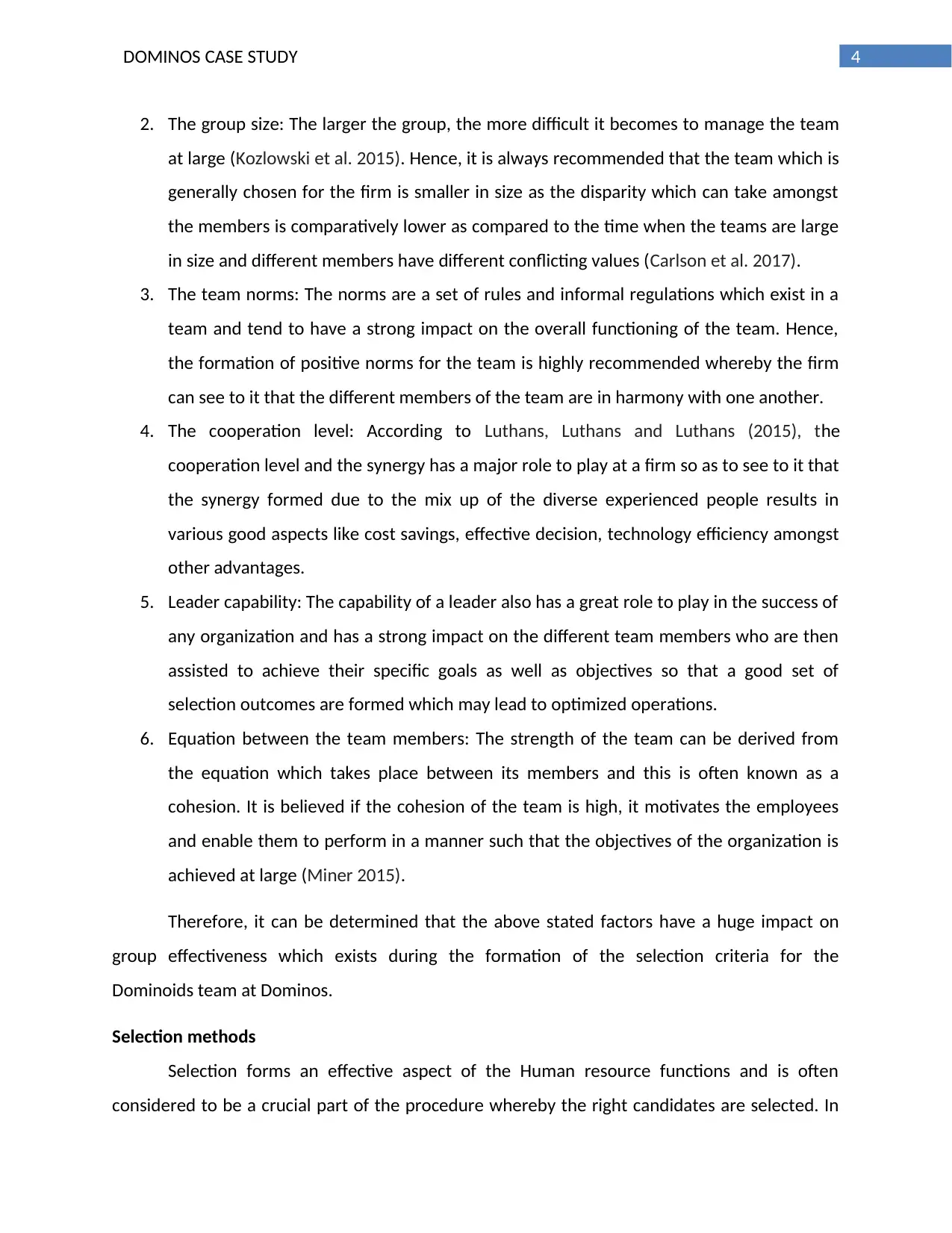
4DOMINOS CASE STUDY
2. The group size: The larger the group, the more difficult it becomes to manage the team
at large (Kozlowski et al. 2015). Hence, it is always recommended that the team which is
generally chosen for the firm is smaller in size as the disparity which can take amongst
the members is comparatively lower as compared to the time when the teams are large
in size and different members have different conflicting values (Carlson et al. 2017).
3. The team norms: The norms are a set of rules and informal regulations which exist in a
team and tend to have a strong impact on the overall functioning of the team. Hence,
the formation of positive norms for the team is highly recommended whereby the firm
can see to it that the different members of the team are in harmony with one another.
4. The cooperation level: According to Luthans, Luthans and Luthans (2015), the
cooperation level and the synergy has a major role to play at a firm so as to see to it that
the synergy formed due to the mix up of the diverse experienced people results in
various good aspects like cost savings, effective decision, technology efficiency amongst
other advantages.
5. Leader capability: The capability of a leader also has a great role to play in the success of
any organization and has a strong impact on the different team members who are then
assisted to achieve their specific goals as well as objectives so that a good set of
selection outcomes are formed which may lead to optimized operations.
6. Equation between the team members: The strength of the team can be derived from
the equation which takes place between its members and this is often known as a
cohesion. It is believed if the cohesion of the team is high, it motivates the employees
and enable them to perform in a manner such that the objectives of the organization is
achieved at large (Miner 2015).
Therefore, it can be determined that the above stated factors have a huge impact on
group effectiveness which exists during the formation of the selection criteria for the
Dominoids team at Dominos.
Selection methods
Selection forms an effective aspect of the Human resource functions and is often
considered to be a crucial part of the procedure whereby the right candidates are selected. In
2. The group size: The larger the group, the more difficult it becomes to manage the team
at large (Kozlowski et al. 2015). Hence, it is always recommended that the team which is
generally chosen for the firm is smaller in size as the disparity which can take amongst
the members is comparatively lower as compared to the time when the teams are large
in size and different members have different conflicting values (Carlson et al. 2017).
3. The team norms: The norms are a set of rules and informal regulations which exist in a
team and tend to have a strong impact on the overall functioning of the team. Hence,
the formation of positive norms for the team is highly recommended whereby the firm
can see to it that the different members of the team are in harmony with one another.
4. The cooperation level: According to Luthans, Luthans and Luthans (2015), the
cooperation level and the synergy has a major role to play at a firm so as to see to it that
the synergy formed due to the mix up of the diverse experienced people results in
various good aspects like cost savings, effective decision, technology efficiency amongst
other advantages.
5. Leader capability: The capability of a leader also has a great role to play in the success of
any organization and has a strong impact on the different team members who are then
assisted to achieve their specific goals as well as objectives so that a good set of
selection outcomes are formed which may lead to optimized operations.
6. Equation between the team members: The strength of the team can be derived from
the equation which takes place between its members and this is often known as a
cohesion. It is believed if the cohesion of the team is high, it motivates the employees
and enable them to perform in a manner such that the objectives of the organization is
achieved at large (Miner 2015).
Therefore, it can be determined that the above stated factors have a huge impact on
group effectiveness which exists during the formation of the selection criteria for the
Dominoids team at Dominos.
Selection methods
Selection forms an effective aspect of the Human resource functions and is often
considered to be a crucial part of the procedure whereby the right candidates are selected. In
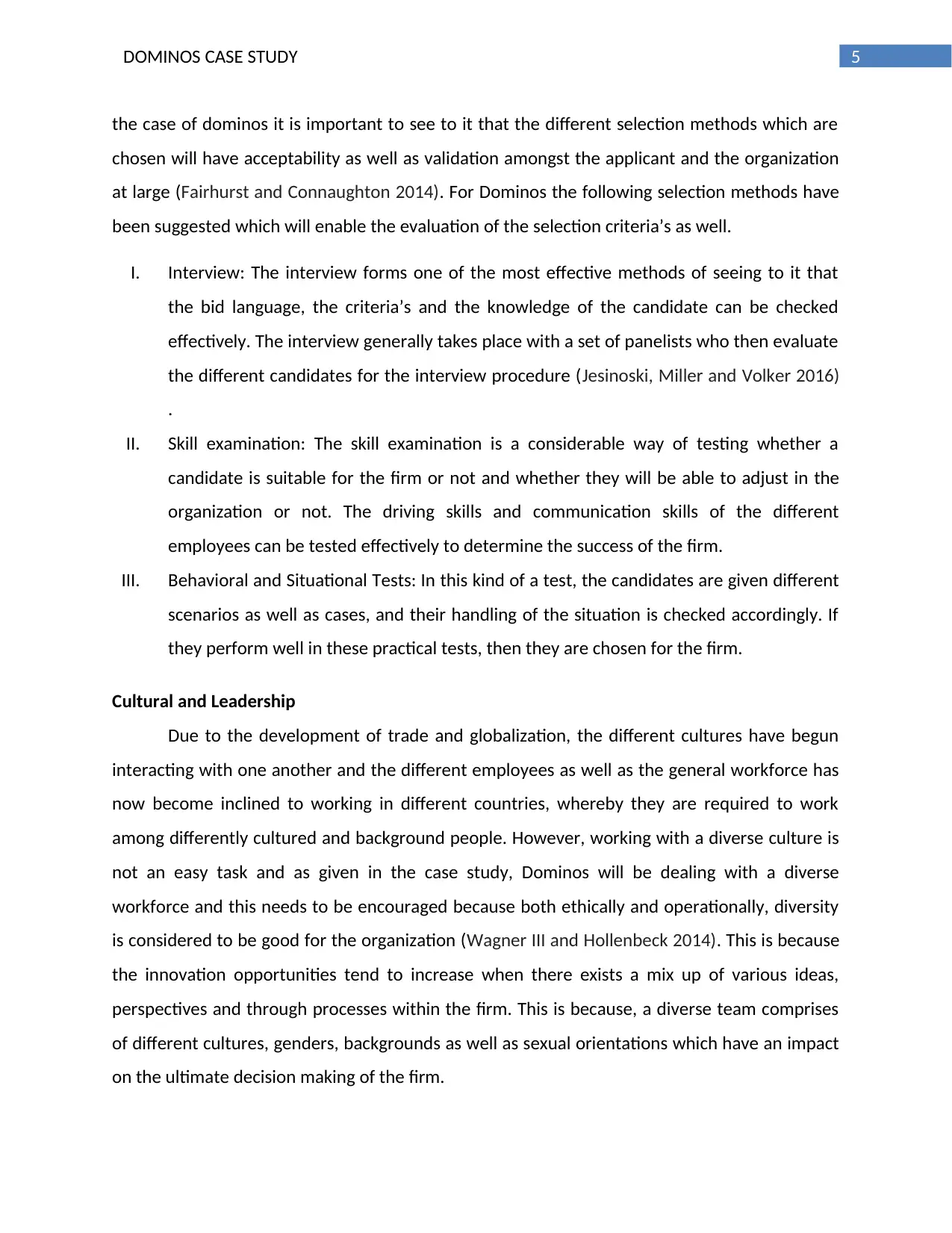
5DOMINOS CASE STUDY
the case of dominos it is important to see to it that the different selection methods which are
chosen will have acceptability as well as validation amongst the applicant and the organization
at large (Fairhurst and Connaughton 2014). For Dominos the following selection methods have
been suggested which will enable the evaluation of the selection criteria’s as well.
I. Interview: The interview forms one of the most effective methods of seeing to it that
the bid language, the criteria’s and the knowledge of the candidate can be checked
effectively. The interview generally takes place with a set of panelists who then evaluate
the different candidates for the interview procedure (Jesinoski, Miller and Volker 2016)
.
II. Skill examination: The skill examination is a considerable way of testing whether a
candidate is suitable for the firm or not and whether they will be able to adjust in the
organization or not. The driving skills and communication skills of the different
employees can be tested effectively to determine the success of the firm.
III. Behavioral and Situational Tests: In this kind of a test, the candidates are given different
scenarios as well as cases, and their handling of the situation is checked accordingly. If
they perform well in these practical tests, then they are chosen for the firm.
Cultural and Leadership
Due to the development of trade and globalization, the different cultures have begun
interacting with one another and the different employees as well as the general workforce has
now become inclined to working in different countries, whereby they are required to work
among differently cultured and background people. However, working with a diverse culture is
not an easy task and as given in the case study, Dominos will be dealing with a diverse
workforce and this needs to be encouraged because both ethically and operationally, diversity
is considered to be good for the organization (Wagner III and Hollenbeck 2014). This is because
the innovation opportunities tend to increase when there exists a mix up of various ideas,
perspectives and through processes within the firm. This is because, a diverse team comprises
of different cultures, genders, backgrounds as well as sexual orientations which have an impact
on the ultimate decision making of the firm.
the case of dominos it is important to see to it that the different selection methods which are
chosen will have acceptability as well as validation amongst the applicant and the organization
at large (Fairhurst and Connaughton 2014). For Dominos the following selection methods have
been suggested which will enable the evaluation of the selection criteria’s as well.
I. Interview: The interview forms one of the most effective methods of seeing to it that
the bid language, the criteria’s and the knowledge of the candidate can be checked
effectively. The interview generally takes place with a set of panelists who then evaluate
the different candidates for the interview procedure (Jesinoski, Miller and Volker 2016)
.
II. Skill examination: The skill examination is a considerable way of testing whether a
candidate is suitable for the firm or not and whether they will be able to adjust in the
organization or not. The driving skills and communication skills of the different
employees can be tested effectively to determine the success of the firm.
III. Behavioral and Situational Tests: In this kind of a test, the candidates are given different
scenarios as well as cases, and their handling of the situation is checked accordingly. If
they perform well in these practical tests, then they are chosen for the firm.
Cultural and Leadership
Due to the development of trade and globalization, the different cultures have begun
interacting with one another and the different employees as well as the general workforce has
now become inclined to working in different countries, whereby they are required to work
among differently cultured and background people. However, working with a diverse culture is
not an easy task and as given in the case study, Dominos will be dealing with a diverse
workforce and this needs to be encouraged because both ethically and operationally, diversity
is considered to be good for the organization (Wagner III and Hollenbeck 2014). This is because
the innovation opportunities tend to increase when there exists a mix up of various ideas,
perspectives and through processes within the firm. This is because, a diverse team comprises
of different cultures, genders, backgrounds as well as sexual orientations which have an impact
on the ultimate decision making of the firm.
⊘ This is a preview!⊘
Do you want full access?
Subscribe today to unlock all pages.

Trusted by 1+ million students worldwide
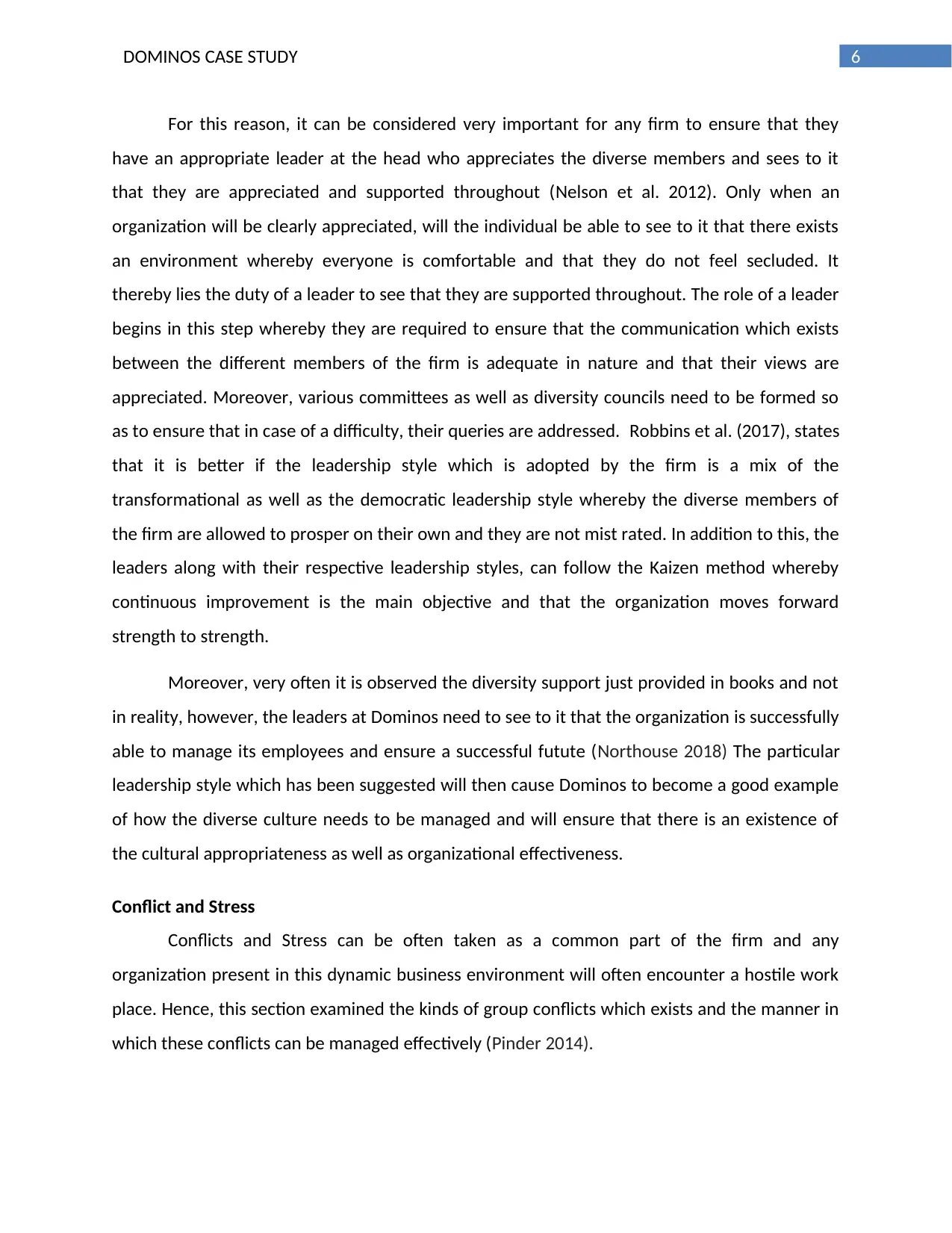
6DOMINOS CASE STUDY
For this reason, it can be considered very important for any firm to ensure that they
have an appropriate leader at the head who appreciates the diverse members and sees to it
that they are appreciated and supported throughout (Nelson et al. 2012). Only when an
organization will be clearly appreciated, will the individual be able to see to it that there exists
an environment whereby everyone is comfortable and that they do not feel secluded. It
thereby lies the duty of a leader to see that they are supported throughout. The role of a leader
begins in this step whereby they are required to ensure that the communication which exists
between the different members of the firm is adequate in nature and that their views are
appreciated. Moreover, various committees as well as diversity councils need to be formed so
as to ensure that in case of a difficulty, their queries are addressed. Robbins et al. (2017), states
that it is better if the leadership style which is adopted by the firm is a mix of the
transformational as well as the democratic leadership style whereby the diverse members of
the firm are allowed to prosper on their own and they are not mist rated. In addition to this, the
leaders along with their respective leadership styles, can follow the Kaizen method whereby
continuous improvement is the main objective and that the organization moves forward
strength to strength.
Moreover, very often it is observed the diversity support just provided in books and not
in reality, however, the leaders at Dominos need to see to it that the organization is successfully
able to manage its employees and ensure a successful futute (Northouse 2018) The particular
leadership style which has been suggested will then cause Dominos to become a good example
of how the diverse culture needs to be managed and will ensure that there is an existence of
the cultural appropriateness as well as organizational effectiveness.
Conflict and Stress
Conflicts and Stress can be often taken as a common part of the firm and any
organization present in this dynamic business environment will often encounter a hostile work
place. Hence, this section examined the kinds of group conflicts which exists and the manner in
which these conflicts can be managed effectively (Pinder 2014).
For this reason, it can be considered very important for any firm to ensure that they
have an appropriate leader at the head who appreciates the diverse members and sees to it
that they are appreciated and supported throughout (Nelson et al. 2012). Only when an
organization will be clearly appreciated, will the individual be able to see to it that there exists
an environment whereby everyone is comfortable and that they do not feel secluded. It
thereby lies the duty of a leader to see that they are supported throughout. The role of a leader
begins in this step whereby they are required to ensure that the communication which exists
between the different members of the firm is adequate in nature and that their views are
appreciated. Moreover, various committees as well as diversity councils need to be formed so
as to ensure that in case of a difficulty, their queries are addressed. Robbins et al. (2017), states
that it is better if the leadership style which is adopted by the firm is a mix of the
transformational as well as the democratic leadership style whereby the diverse members of
the firm are allowed to prosper on their own and they are not mist rated. In addition to this, the
leaders along with their respective leadership styles, can follow the Kaizen method whereby
continuous improvement is the main objective and that the organization moves forward
strength to strength.
Moreover, very often it is observed the diversity support just provided in books and not
in reality, however, the leaders at Dominos need to see to it that the organization is successfully
able to manage its employees and ensure a successful futute (Northouse 2018) The particular
leadership style which has been suggested will then cause Dominos to become a good example
of how the diverse culture needs to be managed and will ensure that there is an existence of
the cultural appropriateness as well as organizational effectiveness.
Conflict and Stress
Conflicts and Stress can be often taken as a common part of the firm and any
organization present in this dynamic business environment will often encounter a hostile work
place. Hence, this section examined the kinds of group conflicts which exists and the manner in
which these conflicts can be managed effectively (Pinder 2014).
Paraphrase This Document
Need a fresh take? Get an instant paraphrase of this document with our AI Paraphraser

7DOMINOS CASE STUDY
Group conflicts
Group conflicts can be defined as the kind of conflict which takes place in a firm when
the different members of a group are in a disagreement with one another. As the diverse
groups comes from a diverse background, there may be certain reasons that they may not
agree with one another and lead to a stressful result for the firm at large (Kakar 2018). This may
have a considerable impact on all the employees and cause stress which thereby negatively
affect the employees both physically and mentally. The consequences of group conflicts have
been given as follows:
It leads to an uneasy corporate environment: When there exists a group conflict at the
workplace, it leads to an easy corporate environment whereby the workplace becomes
hostile and there lies scope for miscommunication as well as fights (Tjosvold, Wong and
Feng Chen 2014). This uneasy environment may then lead to poor mental health of the
employees and permanent exhaustion.
It affects the performance at the workplace: When the employees will be engaged in the
conflicts and be affected by it, there exists chances that they reflect this exhaustion on
their performance and the overall productivity at the workplace may be affected
(Fairhurst and Connaughton 2014). This may ultimately lead to poor performance of
Dominos and lead to pressure on the employees.
Resistance and hatred towards one another: Lastly, when there exists long term
conflicts at the workplace, it may lead to hard feelings among the individuals towards
one another and they may not be willing to work further with each other.
Impact of the stress on organizations, teams and individuals
The stress which takes place at the workplace which is resulted from the group conflicts
may have a negative impact on the employees. Not only on the employees as well as the teams
and the overall firm. These impacts may be as follows:
I. Mental strength: It may have an impact on the mental stability of the employees.
II. Poor employee satisfaction rate: It may cause poor satisfaction rate of the employees
and may lead to higher turnover rates.
Group conflicts
Group conflicts can be defined as the kind of conflict which takes place in a firm when
the different members of a group are in a disagreement with one another. As the diverse
groups comes from a diverse background, there may be certain reasons that they may not
agree with one another and lead to a stressful result for the firm at large (Kakar 2018). This may
have a considerable impact on all the employees and cause stress which thereby negatively
affect the employees both physically and mentally. The consequences of group conflicts have
been given as follows:
It leads to an uneasy corporate environment: When there exists a group conflict at the
workplace, it leads to an easy corporate environment whereby the workplace becomes
hostile and there lies scope for miscommunication as well as fights (Tjosvold, Wong and
Feng Chen 2014). This uneasy environment may then lead to poor mental health of the
employees and permanent exhaustion.
It affects the performance at the workplace: When the employees will be engaged in the
conflicts and be affected by it, there exists chances that they reflect this exhaustion on
their performance and the overall productivity at the workplace may be affected
(Fairhurst and Connaughton 2014). This may ultimately lead to poor performance of
Dominos and lead to pressure on the employees.
Resistance and hatred towards one another: Lastly, when there exists long term
conflicts at the workplace, it may lead to hard feelings among the individuals towards
one another and they may not be willing to work further with each other.
Impact of the stress on organizations, teams and individuals
The stress which takes place at the workplace which is resulted from the group conflicts
may have a negative impact on the employees. Not only on the employees as well as the teams
and the overall firm. These impacts may be as follows:
I. Mental strength: It may have an impact on the mental stability of the employees.
II. Poor employee satisfaction rate: It may cause poor satisfaction rate of the employees
and may lead to higher turnover rates.

8DOMINOS CASE STUDY
III. Productivity: It may have an impact on the productivity of the workplace (Yang and Li
2017).
IV. Customer satisfaction: It may dissatisfy the different customers at large.
V. Operational issues: Moreover, it may also have an impact on the overall operations of
the firm (Gupta and Wingreen 2015).
Managing conflicts
Although conflicts form a common part of the organization, it is crucial that the firm is able to
manage them effectively. The following steps have been recommended for conflict resolution:
I. Encouraging communication and listening: In an organization with a diverse culture,
communication and listening needs to be largely encouraged.
II. Focusing on employee behavior: The behavior of the employees needs to be targeted
and they need to see to it that the employees are easily assisted.
III. Conflict Plans: Conflict plans need to be formed in order to ensure long term success
and guidance (Antonakis and Day 2017).
IV. Responding to agreement and disagreement: Lastly, both agreement and disagreement
need to be responded to.
Conclusion
Hence, from the given examination it can be stated that due to globalization, the
presence of a diverse workforce has become a common aspect in the workplace and hence it
becomes important that the management and the different leaders form effective plans in its
support in order to ensure that there is no barrier to organizational management. The report
highlighted the group effectiveness in case of forming Dominoids selection criteria, which was
then followed by the different factors which affect effectiveness of the team. Lastly, the culture
and leadership along with the role of team conflicts was analyzed. Certain recommendations to
improve the same have also been provided.
III. Productivity: It may have an impact on the productivity of the workplace (Yang and Li
2017).
IV. Customer satisfaction: It may dissatisfy the different customers at large.
V. Operational issues: Moreover, it may also have an impact on the overall operations of
the firm (Gupta and Wingreen 2015).
Managing conflicts
Although conflicts form a common part of the organization, it is crucial that the firm is able to
manage them effectively. The following steps have been recommended for conflict resolution:
I. Encouraging communication and listening: In an organization with a diverse culture,
communication and listening needs to be largely encouraged.
II. Focusing on employee behavior: The behavior of the employees needs to be targeted
and they need to see to it that the employees are easily assisted.
III. Conflict Plans: Conflict plans need to be formed in order to ensure long term success
and guidance (Antonakis and Day 2017).
IV. Responding to agreement and disagreement: Lastly, both agreement and disagreement
need to be responded to.
Conclusion
Hence, from the given examination it can be stated that due to globalization, the
presence of a diverse workforce has become a common aspect in the workplace and hence it
becomes important that the management and the different leaders form effective plans in its
support in order to ensure that there is no barrier to organizational management. The report
highlighted the group effectiveness in case of forming Dominoids selection criteria, which was
then followed by the different factors which affect effectiveness of the team. Lastly, the culture
and leadership along with the role of team conflicts was analyzed. Certain recommendations to
improve the same have also been provided.
⊘ This is a preview!⊘
Do you want full access?
Subscribe today to unlock all pages.

Trusted by 1+ million students worldwide

9DOMINOS CASE STUDY
References
Antonakis, J. and Day, D.V. eds., 2017. The nature of leadership. Sage publications.
Bolza, M 2016, Inside Domino’s family-sized recruitment drive, Human Capital Magazine
(online), 30/09/16, http://www.hcamag.com/hr-news/inside-dominos-familysized-recruitment-
drive224221.aspx
Carlson, J.R., Carlson, D.S., Hunter, E.M., Vaughn, R.L. and George, J.F., 2017. Virtual team
effectiveness: Investigating the moderating role of experience with computer-mediated
communication on the impact of team cohesion and openness. In Remote Work and
Collaboration: Breakthroughs in Research and Practice (pp. 687-706). IGI Global.
Fairhurst, G.T. and Connaughton, S.L., 2014. Leadership: A communicative
perspective. Leadership, 10(1), pp.7-35.
Gupta, H. and Wingreen, S.C., 2015. Examining the effect of social media tools on virtual team
conflicts: A process model.
Jesinoski, T., Miller, G.J. and Volker, J.X., 2016. Entrepreneurial Human Relations And
Organizational Behavior. Business Journal for Entrepreneurs, (4).
Kakar, A.K., 2018. How do team conflicts impact knowledge sharing?. Knowledge Management
Research & Practice, 16(1), pp.21-31.
Kozlowski, S.W., Grand, J.A., Baard, S.K. and Pearce, M., 2015. Teams, teamwork, and team
effectiveness: Implications for human systems integration.
Luthans, F., Luthans, B.C. and Luthans, K.W., 2015. Organizational Behavior: An EvidenceBased
Approach. IAP.
Miner, J.B., 2015. Organizational behavior 1: Essential theories of motivation and leadership.
Routledge.
Nelson, D, Quick, J, Wright, S and Adams, C 2012, OrgB Asia-Pacific Edition, Cengage Learning
Australia
References
Antonakis, J. and Day, D.V. eds., 2017. The nature of leadership. Sage publications.
Bolza, M 2016, Inside Domino’s family-sized recruitment drive, Human Capital Magazine
(online), 30/09/16, http://www.hcamag.com/hr-news/inside-dominos-familysized-recruitment-
drive224221.aspx
Carlson, J.R., Carlson, D.S., Hunter, E.M., Vaughn, R.L. and George, J.F., 2017. Virtual team
effectiveness: Investigating the moderating role of experience with computer-mediated
communication on the impact of team cohesion and openness. In Remote Work and
Collaboration: Breakthroughs in Research and Practice (pp. 687-706). IGI Global.
Fairhurst, G.T. and Connaughton, S.L., 2014. Leadership: A communicative
perspective. Leadership, 10(1), pp.7-35.
Gupta, H. and Wingreen, S.C., 2015. Examining the effect of social media tools on virtual team
conflicts: A process model.
Jesinoski, T., Miller, G.J. and Volker, J.X., 2016. Entrepreneurial Human Relations And
Organizational Behavior. Business Journal for Entrepreneurs, (4).
Kakar, A.K., 2018. How do team conflicts impact knowledge sharing?. Knowledge Management
Research & Practice, 16(1), pp.21-31.
Kozlowski, S.W., Grand, J.A., Baard, S.K. and Pearce, M., 2015. Teams, teamwork, and team
effectiveness: Implications for human systems integration.
Luthans, F., Luthans, B.C. and Luthans, K.W., 2015. Organizational Behavior: An EvidenceBased
Approach. IAP.
Miner, J.B., 2015. Organizational behavior 1: Essential theories of motivation and leadership.
Routledge.
Nelson, D, Quick, J, Wright, S and Adams, C 2012, OrgB Asia-Pacific Edition, Cengage Learning
Australia
Paraphrase This Document
Need a fresh take? Get an instant paraphrase of this document with our AI Paraphraser
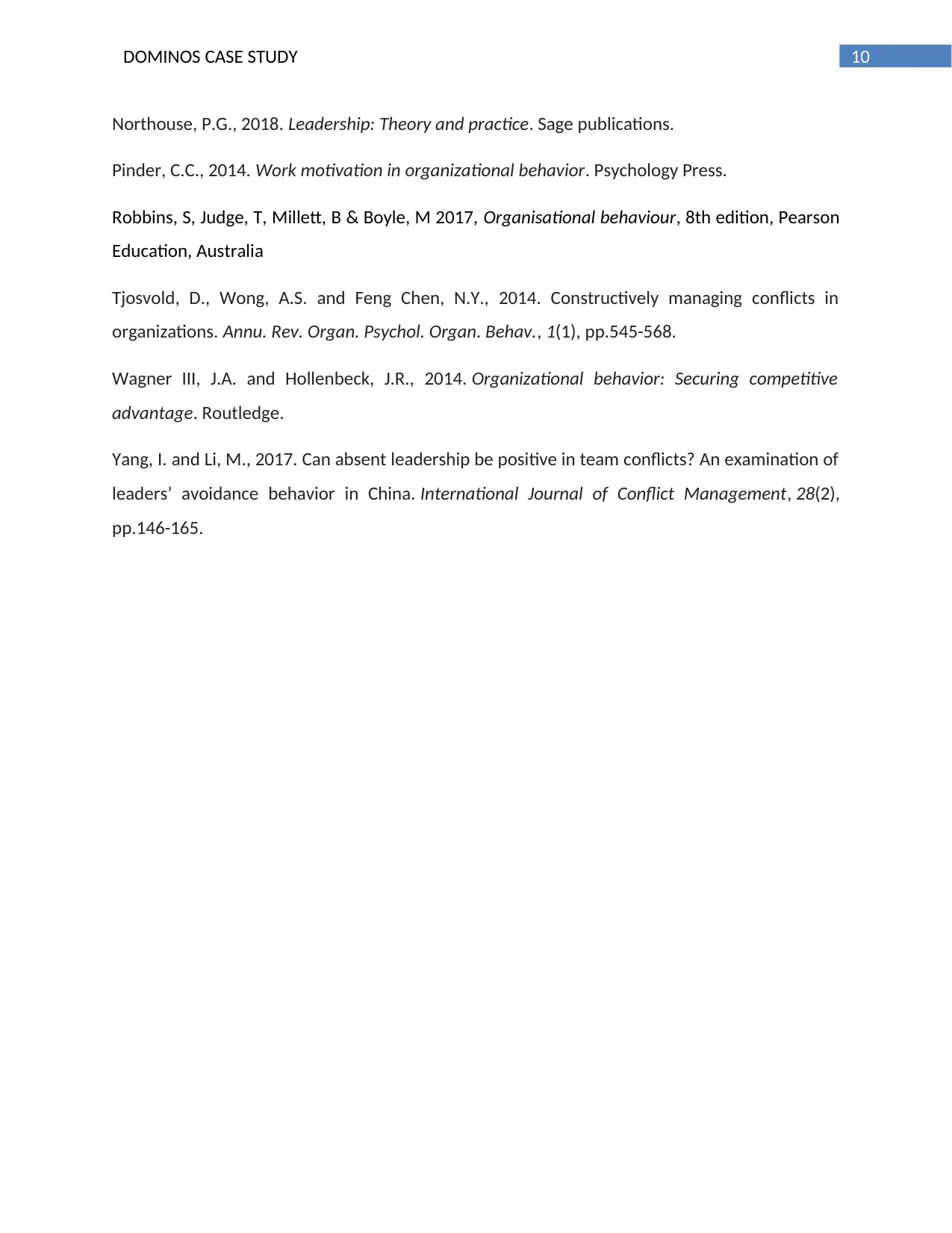
10DOMINOS CASE STUDY
Northouse, P.G., 2018. Leadership: Theory and practice. Sage publications.
Pinder, C.C., 2014. Work motivation in organizational behavior. Psychology Press.
Robbins, S, Judge, T, Millett, B & Boyle, M 2017, Organisational behaviour, 8th edition, Pearson
Education, Australia
Tjosvold, D., Wong, A.S. and Feng Chen, N.Y., 2014. Constructively managing conflicts in
organizations. Annu. Rev. Organ. Psychol. Organ. Behav., 1(1), pp.545-568.
Wagner III, J.A. and Hollenbeck, J.R., 2014. Organizational behavior: Securing competitive
advantage. Routledge.
Yang, I. and Li, M., 2017. Can absent leadership be positive in team conflicts? An examination of
leaders’ avoidance behavior in China. International Journal of Conflict Management, 28(2),
pp.146-165.
Northouse, P.G., 2018. Leadership: Theory and practice. Sage publications.
Pinder, C.C., 2014. Work motivation in organizational behavior. Psychology Press.
Robbins, S, Judge, T, Millett, B & Boyle, M 2017, Organisational behaviour, 8th edition, Pearson
Education, Australia
Tjosvold, D., Wong, A.S. and Feng Chen, N.Y., 2014. Constructively managing conflicts in
organizations. Annu. Rev. Organ. Psychol. Organ. Behav., 1(1), pp.545-568.
Wagner III, J.A. and Hollenbeck, J.R., 2014. Organizational behavior: Securing competitive
advantage. Routledge.
Yang, I. and Li, M., 2017. Can absent leadership be positive in team conflicts? An examination of
leaders’ avoidance behavior in China. International Journal of Conflict Management, 28(2),
pp.146-165.
1 out of 11
Related Documents
Your All-in-One AI-Powered Toolkit for Academic Success.
+13062052269
info@desklib.com
Available 24*7 on WhatsApp / Email
![[object Object]](/_next/static/media/star-bottom.7253800d.svg)
Unlock your academic potential
Copyright © 2020–2025 A2Z Services. All Rights Reserved. Developed and managed by ZUCOL.




